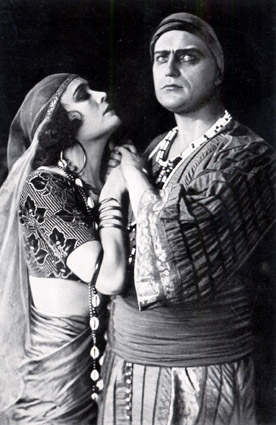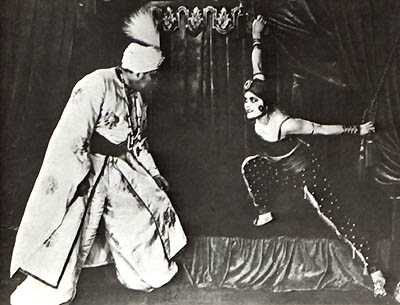
SUMURUN…At Long Last!
A review by David Gasten
September 30, 2006 (Updated December 5, 2006)
Sumurun (Decla-Bioscop/UFA, 1920), starring Pola Negri, Ernst Lubitsch, Paul Wegener, Harry Liedtke, Jenny Hasselquist, Egede Nissen, and Carl Clewig. Directed by Ernst Lubitsch. Silent film, 103 minutes. Restored by the F.W. Murnau Stiftung, 2005. DVD released by Kino Video on December 5, 2006.
Click to purchase Kino Video's restored, uncensored version of Sumurun![]() at Amazon.com.
at Amazon.com.
 |
Kino Video's DVD reissue of Sumurun. That's Jenny Hasselqvist, not Pola Negri, on the cover. Hasselqvist played the title role of Sumurun, the harem favorite, in this movie. |
Sumurun! Holy cow! I now understand what Erich von Stroheim meant when he said the two-hour release version of Greed (as compared to the eight-hour original version) was like the skeleton of his dead child. For decades, we Americans have watched the butchered version of Sumurun, entitled One Arabian Night on our shores, and thought, “So what?” In fact, when I learned that there was a restored version of this film, I thought, “Why didn’t they do Carmen first? One Arabian Night is kind of a clunker.” Well, now that I’ve seen the restored, uncensored, REAL version of Sumurun, I understand why they chose to restore it. Watching this new version of Sumurun made me fall in love with Pola all over again—particularly with her lethal sex appeal. This is what made American audiences fall for her so hard that Paramount brought her over here. And yet her hard-hitting sexuality was all but cut out of the American version of this picture, which is in part why you don’t really see too many wild raves about this picture in the vintage papers. But there will be wild raves now and I’m happy to lead the pack.
Pola originally played the role of the dancer in a Polish theatrical version of Sumurun, which the great German theater director Max Reinhardt was made aware of. He invited Pola to Germany based on what he saw, an offer which Pola took him up on. Reinhardt liked the Sumurun play as well and decided to revive the play in Germany, and of course cast Pola in the role as the dancer for the German theatrical version. It was here that Pola met Ernst Lubitsch, who was a Reinhardt player and comedy short director at the time, and who happened to be cast in the role of the hunchback opposite Pola in the German theatrical version. Pola and Lubitsch had such a chemistry together and became such good friends that he took her with him when he started directing large-scale costume pictures for UFA.
Lubitsch's costume films starring Pola were a large risk for UFA at first, but turned out to be an overwhelming worldwide success. First there was The Eyes of the Mummy, then Carmen, then Madame DuBarry, each larger and more successful than the next. After Madame DuBarry pretty much set the world on fire, Lubitsch was in the place where he couldn’t exactly top himself with something bigger. So what did he do? He pulled the old trick of remaking a previous success, that success being the theatrical success of Sumurun that had brought him and his star together in the first place. Since the kinetic energy they shared together had already traveled from the stage to the screen, why couldn’t their original chemistry in Sumurun be translated to the screen and keep the ball rolling? And sure enough, it did. In America, it may not have been a great picture, but hey, it was the next Pola movie to see—hubba hubba! “There she goes, getting chased around the boudoir by Paul Wegener—wow, I wish that were me chasing her around!”
 |
The Dancing Girl (Pola) falls hard for The Merchant (Harry Liedtke), but he is too stuck on Sumurun to respond favorably to her advances. Why do girls always want the guy they can't get? This is the only time that I know of that Pola played opposite Harry Liedtke where two to do not fall in love on screen. (Photo courtesy Kino International) |
The story here is a complicated soap opera of a story, it being a retelling of one of the Arabian Nights stories, hence the American title One Arabian Night. It’s a love HEXangle—that’s right, drama queens, there’s SIX characters chasing each other around and killing each other in the name of love. In the highest of demand is Pola’s character, the dancing girl. She’s in a troupe of traveling minstrels, one of which is a lute-playing hunchback, played by Ernst Lubitsch in his one and only time acting onscreen with Pola. The hunchback is insanely jealous of anyone of the male persuasion who pays attention to Pola (and there are plenty), even though Pola always ignores him. Meanwhile, back at the palace, the Grand Sheik, played by Paul Wegener of The Golem fame, has caught Sumurun (played by Swedish actress Jenny Hasselqvist), the favorite girl of his (gigantic) harem, making eyes with someone on the grounds below. The person she’s in love with is a wealthy textile merchant Nour Al Din, played by Harry Leidtke, who is likewise smitten by her. Just as the Grand Sheik has his dagger raised and is about to kill Sumurun for her unfaithfulness, one of the eunuchs announces that there’s word of a beautiful new dancing girl (i.e. Pola) that would be a wonderful addition to the harem. The Grand Sheik is so interested that he forgets all about killing Sumurun right there and drops her and the knife on the spot with a big *plop*. Sumurun still gets sentenced to death for her unfaithfulness, so one of the other harem girls gets the head eunuch to get the sheik’s son (The Prince) to go before the Sheik and say it was he that she was making eyes at, which of course keeps Sumurun from being killed. The Sheik tries to apologize and take Sumurun back, but of course Sumurun wants nothing to do with him now (gee, I wonder why?). Meanwhile the Prince sees Pola and they fall for each other. The Sheik goes to see Pola dance, likes what he sees, and takes her from the troupe in exchange for a good sum of money. Oh yeah, and amongst all this Pola falls for The Merchant too, but that situation goes unrequited because of The Merchant's love for Sumurun. And the soap opera continues from there, with three of the characters winding up dead in the end.
The Grand Sheik, The Prince, The Hunchback, The Merchant, The Harem Favorite, and The Dancing Girl. Confused? If you saw One Arabian Night, the American release of this film, you would be. But in the original European version, the story unravels so fluidly you don’t even realize how complex the story really is. The story rollicks along as each of these colorful characters and plot elements is unveiled one piece at a time. The visuals are so strong and the story so self-contained they don’t even have to use that many intertitles.
The secret to telling this story so successfully was to use characters that look much different from each other and to focus on each character’s personality a bit, using varying degrees of humor with each one. In other words, the movie does all the work so you don’t have to. But before you begin bowing to the genius of Almighty Director Lubitsch and putting oranges in front of his likeness, keep in mind that this movie is a remake of a remake; in other words, Lubitsch adapted the already existing story to the screen from Max Reinhardt’s hit German theatre version, which Reinhardt in turn took from the Polish theatre. So what we have is one innovator building on the developments of the previous innovator. This success is at the end of a long progression of developments that we are seeing after all the innovations have been compiled together, one brick at a time.
Primitive Lubitsch Touch
Of course the first question people are going to ask is a pretty obvious one. That would be: “This picture was released in 1920, which is older than any Lubitsch picture I’ve ever seen. Did he have The Lubitsch Touch back then?” Answer: Yes, and amply so, but in a primitive form. For those not in the know, “The Lubitsch Touch” is a name that has been adopted for Lubitsch’s unique directing style. Like Hitchcock, Lubitsch understood the art of drawing pleasure from suspense and added it liberally to his directing style. He lets you know what’s coming but makes you wait for it. When Hitchcock uses suspense, you’re waiting for something awful to happen, and you cringe and cringe as Hitchcock makes you wait and wait for the impending horror. When Lubitsch uses suspense, it’s more like you’re holding your breath and waiting to be kissed, while the girl who is about to kiss you teases you a bit and waits to actually do the deed while still making you hold your breath. Hitchcock draws it out torturously; Lubitsch is much more subtle about it to the point where you don’t even realize he’s doing it, even if you do feel the effects of it. This is why people generally have a hard time describing “The Lubitsch Touch”. They know it when they see it, and they know that Lubitsch is the only one who does it, and yet, because of its subtlety, they can’t quite describe what it is they’ve just seen.
In Sumurun, it appears that Lubitsch was just starting to use this device, and it’s possible some of it was already built into the story. The best example here involves The Hunchback (Lubitsch’s character), who is so lovesick for Pola that when he realizes that she’s being shipped off to The Sheik’s harem, he takes a magic potion that puts him into a deathlike sleep. We know without a doubt what’s going to happen to him, but after he takes the potion, he dances around in a blissful, “I could care less” state for a while before he goes out like a light, and even when he drops he takes his sweet time at doing it. Next, Pola sees Lubitsch as she’s on her way out the door en route to The Sheik. She thinks he’s hunched over because he’s depressed about her going, so she tries to nudge him out of it. She stays at it for an elongated stretch of time and we are just waiting for the inevitable—and then she finally realizes he’s out and, of course, thinks he’s dead. The old lady who runs the minstrel troupe then comes upon Lubitsch’s body, and seeing the potion realizes what he’s done. Then a long and drawn-out (but fun) side story develops where the hunchback’s body is accidentally carried off by The Merchant's assistants and the old lady runs after the kidnappers trying to recover his body without being seen herself. Finally The Hunchback is accidentally carted off to the palace, and the accidental unveiling of the “dead” body scares away the eunuchs who carted it there. So the old woman starts working the Hunchback out of his vegetative state, first with smelling salts, which stir him a bit but don’t work. She then tries putting a stick up his nose. She gets a sneeze out of him, he stirs a bit…and he konks back out. She’s elated about the progress and goes for the stick-in-the-nose trick again, and…and…and…you get the point.
It’s very possible that this particular series of scenes may have been what sparked him to try using this type of suspense more and more in his movies until it became the trademark part of his directing style, although I currently have no proof that this is the case. Of all the Lubitsch pictures I’ve seen, this use of suspense certainly doesn’t appear before this, so whatever that tells you.
The humor runs rampant in this story of love, jealousy and murder too. One of my favorite funny scenes is when The Hunchback is trying to make his way to the stage where a rival suitor for Pola’s affections stands, and all you see is the neck of his lute swimming through the dense crowd toward the stage like a befuddled buoy. There’s a lot of silly slapstick, especially concerning the merchant’s assistants who slap, bite, and even spank each other amongst other roly-poly Keystone Cop madness. At one point, they see the old lady who runs the minstrel troupe peeking through the window and they swat a broom at her like a flyswatter. Also, the interaction between the second-in-command harem girl and the head eunuch is great. I love it when she’s trying to cajole the head eunuch into saving Sumurun from execution, and tells him that if he were a REAL man, he’d do it for her. If the eunuch were a "real man"--ha ha! (Note: this particular line gets lost in the translation in the Kino DVD edition's English-language intertitles, but it is there in the version with German-language intertitles with French subtitles that was shown on the Arte channel in France.) The list of great humor goes on and on from here.
Sexy Pola
|
The Grand Sheik (played by Paul Wegener) chases Pola around the boudoir in Sumurun. Mrrrrrow! |
Oh, and let’s not forget about Pola. In simple, unpretentious terms, she’s hot. Really hot! There’s a reason why almost all of the men in this picture want her so badly (except, amazingly, for Harry Leidtke’s character, who as mentioned is stuck on Sumurun). Pola shakes, cavorts, gyrates, slides, wiggles, and trips all over this picture, almost always with a least a little midriff showing, if not a whole bunch.
The amount of dancing in Sumurun is the most I’ve seen in any of her pictures up to this point. One of the dancing moves she does has her hunched in a ball with a veil around her; the way she opens up out of this position literally looks like a flower blossoming right before your eyes. Wow. (A little bit of this “flower trick” shows up in the American version, but it loses its impact.) The topper in the sex appeal department is, of course, when she gets to the Sheik’s bedroom and makes him chase her around the room. In the American version we get one little taste of it that really stands out, but in the European version it’s The Grand Finale of Pola’s prowess, complete with her snaking backwards on the floor (which is also cut from the American version, of course).
After seeing the restored Sumurun, I fear that I may never be able to see One Arabian Night in the same way again. Eighty-six years is an awfully long wait for the good version, but hey, at least the original’s not a lost film. Thank you to the F.W. Murnau Stiftung for making this available to us, and to Kino Video for releasing this picture on video; I can’t recommend it more. Now we need good restorations of Carmen, Madame DuBarry, Mazurka, and, most of all, Forbidden Paradise. This release of Sumurun and the simultaneous release of the restored Die Bergkatze (aka The Wildcat) definitely give us hope that it could happen.


